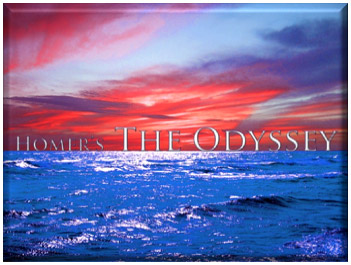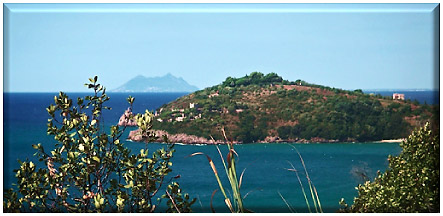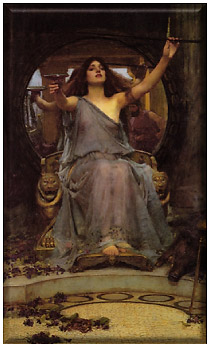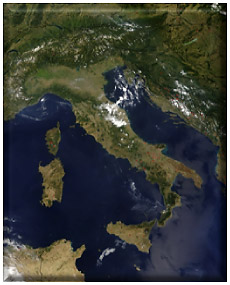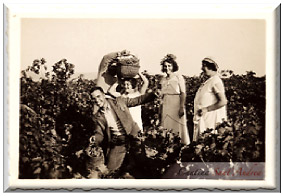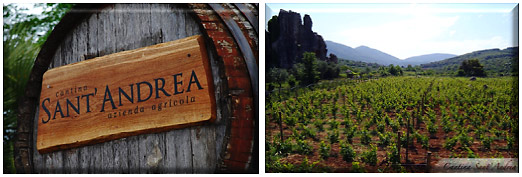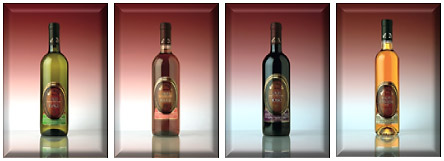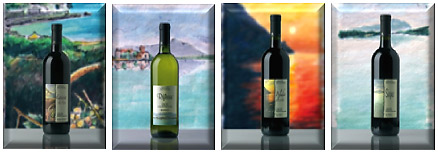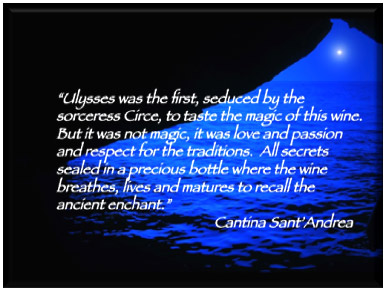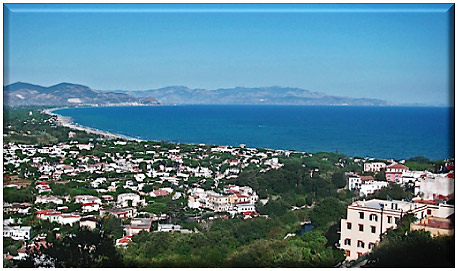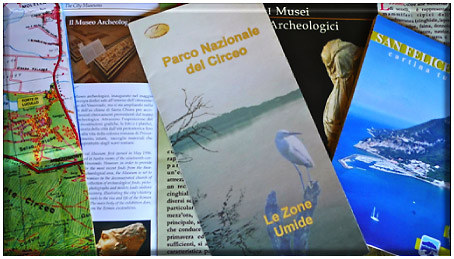|
In Search of Their
Private Ithaca
Story by Tom Weber
In Homer's Greek epic poem The Odyssey, following the Trojan War, Ulysses, the King of Ithaca, and his men set sail for home on a journey that would take ten years to complete. During their voyage, and desperately in need of provisions, they follow the winds up the Mare Tirrenia (Tyrrhenian Sea) along the Italian coast and reach what they believe is the island of Aeaea - not an island at all, but rather Capo di Circeo (Cape of Circeo), a small peninsular coastline nestled in the southwest corner of the Lazio region less than 60 mi. from Rome.
According to classical Roman writers, the island of Aeaea was identified as Monte Circeo (Mount Circeo) on Capo Circaeum (Cape Circeo). It may have been an island in Homer's time (ca. 8-7 century BC), with marshes and sea surrounding its base; but, today, it's a small peninsula with a long lido (sandy beach) that's attached to the mainland. Archeologists have identified one grotto on Cape Circeo as La Grotta della Maga Circe (the Cave of the Sorceress Circe). During Homer's time, the "island" is the home of the beautiful sorceress Circe. Upon entering her palace in search of food and drink, Circe drugs a band of Ulysses' men and turns them into swine and confines them to a pigsty. When Ulysses goes to rescue them, Hermes, the messenger of the gods, approaches him and tells Ulysses to eat the magical herb moly, which will protect him from Circe's black magic. When offered, Ulysses accepts the cup from Circe, knowing that he is well protected from her magical spells. Circe, realizing she is now powerless over him, falls madly in love with Ulysses, returns his men to their human form, and welcomes them all into her palace for a year-long stay of leisure and luxury. Ulysses men finally grow homesick and beg their king to leave Aeaea and set sail, once again, for Ithaca. He agrees, and Circe provides them with plenty of provisions and advice on dealing with the dangers that still lie ahead for Ulysses and his crew. La Famiglia Pandolfo - Their Odyssey Begins
Fast forward to mid 19th century Pantelleria -- a tiny, 32 sq. mi. volcanic island in the Mediterranean Sea, 60 mi. southwest of the mother island of Sicily and just 36 mi. east of Tunisia and the African coast. Here, Andrea Pandolfo I begins to hone his craft cultivating fine wines from the Zibbibo/Moscato (Muscat) grape on his small farm.
Tunisia Bound Not satisfied with the limited production on Pantelleria, the Pandolfo patriarch sold the Sicilian island vineyard in 1880, purchased 150 acres of virgin land in Khanguet Gare in the Cap Bon region and moved his family and his passion for wine making to Tunisia. Highly successful blending wines in the family cellar, the Pandolfo brand was regular cargo at the Port of Tunis bound for the finest wine markets of France.
Down, But Not Out Because this is a real-life odyssey, complete with satisfying peaks are arduous valleys, Mother Nature struck Pandolfo's Tunisian vineyards in 1938 as the vine borer phylloxera laid waste to the entire crop. Andrea Pandolfo II, now in charge of the family business at the ripe old age of 16, kept his grandfather's legacy alive. He burned the diseased crop, replacing the land with newly grafted plants brought in from France that were resistant to disease; and, soon, the red desolate earth began to green as the vines took root and grapes began to grow again.
Just When You Thought It Couldn't Get Any Worse Unfortunately, the Pandolfo odyssey grows much worse before it gets better. In May 1964, the Tunisian National Assembly decrees the expropriation of all land in foreign hands -- owned primarily by Italian and French families -- in order to create 300 state-run cooperative farms; so, Andrea II and the rest of his "crew" pack up their belongings and, like Ulysses, follow the winds up the Italian coast to start a new life in the shadows of Capo Circeo and the myth of Circe. Cantina Sant'Andrea - La Famiglia Pandolfo's Private Ithaca
Upon arrival in Italy, Andre II purchases a small estate in Borgo Vodice, in the Latina province of the Lazio near the center of the Agro Pontine (Pontine Plain) - a 310 sq. mi. area of malaria-infested marshlands that, under the direction of the Mussolini government of the 1930s, was drained, tamed, cultivated and brought back to life. In honor of bisnonno (great-grandfather) Andre Pondolfo I, the new winery was named Cantina Sant'Andrea. Led by Andre II, the family tilled the bittersweet land and began enjoying the fruits of their labor with the birth of the estate's first vintage in 1968.
With a handful of chestnut barrels and wine bottles identified by simple hand-written labels, the customers began to arrive and the family tradition began to flourish once again. Today, Cantina Sant'Andrea boasts an array of 29 different wines and spirits divided into two distinct lines: Linea Classica and Selezione Acquerelli. Linea Classica
Comprised of 15 different DOC and IDT-rated (Indicazione Geografica Tipica - Typical Geographical Indication) blends, Linea Classica (Classic Line) represents the historical soul of the Pandolfo estate, since its rebirth in the 1960s back on Italian soil, in each and every bottle produced. With their distinctive and original barrel-shaped labels, these blends are the ones that have made Cantina Sant'Andrea a well-respected and appreciated brand by connoisseurs, wine critics and loyal customers alike. Selezione Acquerelli
Normally, higher quality lines of Italian wine are classified by their vintners with industry standard terminology, like Riserva (Reserve) or Superiore (Superior); but, in the case of Cantina Sant'Andrea, its showcase blends of 14 different DOC titles are marketed as Selezione Acquerelli (Watercolor Selection), due to each blend's distinctive watercolor print bottle label. According to Gabrielle Pandolfo, the current patriarch, "Selezione Acquerelli represents the maximum expression of the three key elements that every wine should have: nature, humanity and technology." The Selezione Acquerelli is a limited production line destined for the very best restaurants, the most important domestic and international vintage wine stocks, and the most refined and demanding palates.
As Cantina Sant'Andrea's website homepage attests, the link between the Pandolfo family, Ulysses and the sorceress Circe is alive and well. You could say the Pandolfos, after their more than 150-year personal odyssey, have finally and permanently returned home to their private Ithaca, just like Ulysses did so many centuries ago in Homer's The Odyssey. See You in the Circei!
Should your future travel plans include Italy, make it a point to visit this enchanting little corner of the Lazio and ask for Cantina Sant'Andrea wines when you dine; but, a word of caution: Don't forget to bring along the magical herb moly…you just never know when the sorceress Circe might be your server. Good Eats – Good Wines – Good Linens – Good Sights
Recommended Eats: Ristorante da Vincenzo – Borgo San Vito, San Felice Circeo - Seafood is the specialty here highlighted by the best zuppa di pesce (fish soup) in the area, both classic style and shellfish-only. Also noteworthy is the antipasto of moscardini (deep fried miniature octopus). Recommended wine is the uniquely dry Oppidum Moscato di Terracina. Trattoria Il Grottino – Centro Storico, San Felice Circeo – Outdoor dining for the entire family with panoramic views along the Tyrrhenian Coast down to Gaeta and the Pontine Archipelago out at sea. Pick your fresh catch-of-the-day right from the establishment's holding tank. Great starters are the huge plates of fresh steamed cozze (mussels) and vongole (clams). Recommended wine is Riflessi Bianco di Circeo. Recommended Wines: Cantina Sant'Andrea – You already know the story of La Famiglia Pandolfo; so, now go see for yourself. Primary vineyards, production facility and outlet store located at Borgo Vodice on Via del Renibbio Podere. Just follow the botte (barrels) signs along regional road 148 (Pontina) and you'll be there. Additional outlet stores in nearby Latina, Sabaudia and Terracina. Online information at: www.cantinasantandrea.it. Recommended Linens: Bed & Breakfast I Lecci – Via IV Novembre, San Felice Circeo - Family run b&b with clean, comfortable and reasonably priced bungalows and multi-room apartments, all with air conditioning, flat screen TVs and WIFI. Complimentary r/t shuttle service to the b&b's exclusive section on the Lido di Circeo, with umbrellas and lounge chairs. Free use of their stable of bicycles, too, for a fun way to take in the sights and burn off those calories you added during the complimentary breakfast. Online information at: www.bebilecci.it/eng/index.php. Recommended Sights: San Felice Circeo – The history of this bustling little seaside town along the Tyrrhenian Sea is filled with myths and legends that give it an unequal appeal. The Neanderthal were here; forces from Imperial Rome kept the peace for a time followed by the Papacy; and last, but certainly not least, the mysterious Knights Templar settled in Circeo for a spell. Detailed online tourist information at: www.sanfelicecirceo.net/en/index.shtml. National Park of Circeo – The only park of its kind in Italy to include both a plain and coastal area. The park is divided into five main habitats: the forest, the promontory, the coastal dunes, the wetlands and the island of Zannone. Online tourist information at: www.parks.it/parco.nazionale.circeo/Eindex.php. Terracina – Sitting along the historic Via Appia (Appian Way) 60 mi. south of Rome and adjacent to San Felice Circeo, this port city and seaside resort claims its heritage first from the Etruscans, then the Volscians and finally the Romans. It is the only point where the mountains reach down to touch the Tyrrhenian Sea. Landmarks of note are the Temple of Jupiter, the Emilian Forum, Piazza Municipale and the Trajan Port. Not to be overlooked is a boat ride out to the Pontine Archipelago to take in the five islands that make up the chain: Ponza, Palmarola, Zannone, Ventotene and San Stefano. Online tourist information at: www.terracina.eu. Related Articles: |
